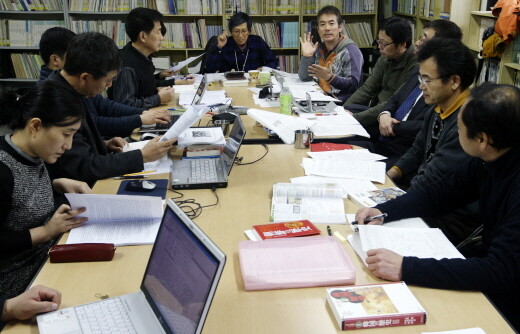hankyoreh
Links to other country sites 다른 나라 사이트 링크
S.Korean, Chinese and Japanese history textbooks diverge on historical accounts

South Korea, China and Japan have been presenting very different explanations of major East Asian historical events in their respective history textbooks. All three countries have either entirely omitted to mention or presented very biased accounts of incidents they deem either unrelated or disadvantageous to themselves. Some observers are highlighting the need to shift the focus of history education from “one’s own history” to “a history of relationships” in order to broaden the shared historical understanding among people from the three countries.
The Hankyoreh and the Asia Peace and History Education Network (APHEN) have been collaborating on the compilation of East Asian history teaching materials to commemorate the 91st anniversary of the March 1 independence movement. The Hankyoreh and APHEN analyzed the presentation in Korean, Chinese and Japanese middle school textbooks of ten historical incidents and concepts that had a major impacts on the three nations, including the Four Commanderies of Han, the Joseon-Japanese War in 1592 and Japan’s colonial rule. The textbooks analyzed included South Korea’s “Guksa (Korean History),” published by the Ministry of Education and Human Resources Development, and the first and second grade editions of “Sahoe (Society),” published by Kumsung Publishing, Japan’s “New Society-History,” published by Tokyo Shoseki, and the seventh and eighth grade editions of “Chinese History” and the ninth grade edition “World History” from China’s compulsory education standard experimental textbooks, published by the People’s Education Press.
In general, Chinese textbooks are strongly lacking in accounts related to Korea. In “World History,” the only mention of Korea is in a sidebar entitled “Ancient Joseon.” In “Chinese History,” not only did the role of Goguryeo in the fall of the Sui Dynasty disappear after 2000, but there is no mention of the the Joseon-Japanese War in 1592. Kim Ji-hoon, research professor of Sungkyunkwan University and head of APHEN’s China committee, said this was the result of the fact that the “History Curriculum Standards,” China’s 2001 textbook-writing guidelines, deleted Korea-related content areas. Kim said, “Judging from the fact that references to Korea’s economic development have increased in social studies courses, this could be interpreted as reflecting the perspective on Korea held by modern Chinese.”
The Tokyo Shoseki textbook, which has been adopted by around 50 percent of Japanese middle schools, presents relatively accessible treatments of the three nations’ history with a focus on their relationships. This stands in marked contrast with prominent examples of distorting textbooks such as those by Fusosha Publishing. While some differences from the Korean version are seen with regard to the theory of the Japanese outpost of Imna in South Korea during the fourth century, the book did attempt brief but objective accounts of areas such as the inequality of the Treaty of Ganghwa between Japan and Joseon in 1876, the causes of the March 1 independence movement and Japan’s armed suppression in response in 1919, the fabrication of the Manchuran Incident by the Japanese military in 1931, and the victimization of Koreans and Chinese through labor conscription. However, only a brief account is given for the Nanjing Massacre in 1937, without mentioning the extent of the atrocities, and no reference made to the conscription of women to serve as sexual slaves for the Japanese military.
Korean textbooks are no different in focusing on their own history in their accounts. The Korean textbooks analyzed do not mention of the Sino-Japanese War in 1894, which was decisively influential in reorganizing the international order in late 19th century East Asia, or the Nanjing Massacre. The world history textbook studied by second year middle school students in middle school places a predominant emphasis on accounts of Western history, while the development process of the East Asian nations was presented in a manner that is difficult to understand chronologically. And whereas Japanese textbooks deal in detail with the issue of Japan’s postwar reparations, currently a major point of contention between South Korea and Japan, South Korean textbooks made almost no reference to them.
APHEN steering committee head Kim Min-cheol said, “Ultimately, history education is the most important thing for the sake of a peaceful future in East Asia,” adding that the three countries “need to abandon their biased accounts centered on their own histories and share more with their neighbors.”
Please direct questions or comments to [englishhani@hani.co.kr]
Editorial・opinion
![[Column] Is Korean democracy really regressing? [Column] Is Korean democracy really regressing?](https://flexible.img.hani.co.kr/flexible/normal/500/300/imgdb/original/2024/0705/2917201664129137.jpg) [Column] Is Korean democracy really regressing?
[Column] Is Korean democracy really regressing?![[Column] How tragedy pervades weak links in Korean labor [Column] How tragedy pervades weak links in Korean labor](https://flexible.img.hani.co.kr/flexible/normal/500/300/imgdb/original/2024/0703/8717199957128458.jpg) [Column] How tragedy pervades weak links in Korean labor
[Column] How tragedy pervades weak links in Korean labor- [Column] How opposing war became a far-right policy
- [Editorial] Korea needs to adjust diplomatic course in preparation for a Trump comeback
- [Editorial] Silence won’t save Yoon
- [Column] The miscalculations that started the Korean War mustn’t be repeated
- [Correspondent’s column] China-Europe relations tested once more by EV war
- [Correspondent’s column] Who really created the new ‘axis of evil’?
- [Editorial] Exploiting foreign domestic workers won’t solve Korea’s birth rate problem
- [Column] Kim and Putin’s new world order
Most viewed articles
- 110 days of torture: Korean mental patient’s restraints only removed after death
- 2Months after outcry over “torture devices,” Justice Ministry proposes more restraints for immigratio
- 3Beleaguered economy could stymie Japan’s efforts to buoy the yen
- 4[Column] Is Korean democracy really regressing?
- 5Koreans are getting taller, but half of Korean men are now considered obese
- 6[Column] How tragedy pervades weak links in Korean labor
- 7Former bodyguard’s dark tale of marriage to Samsung royalty
- 8Real-life heroes of “A Taxi Driver” pass away without having reunited
- 9[Editorial] Exploiting foreign domestic workers won’t solve Korea’s birth rate problem
- 10Democrats ride wave of 1M signature petition for Yoon to be impeached